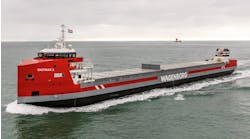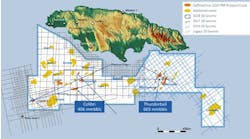View Article as Single page
Reverse-circulation cementing
Circulation in deepwater wells is a topic of research interest, too. RPSEA heard the final report on deepwater reverse-circulation primary cementing from Crystal Wreden of CSI Technologies. The project objective was to assess reverse circulation cementing to reduce circulation pressure requirements in deepwater. Accessing the annulus from the rig floor in deepwater is one hurdle, and new downhole tools may be the answer. One such tool under development is a crossover design based on a gravel pack tool that can work for both conventional and reverse-flow cementing is probably the quickest route to success. A second tool under study is one that can switch the cement flow between the annulus and the drill pipe, and this maybe the better long-term solution. Contributing to the work is a program developed for use by the University of Houston (UH) that can simulate reverse cementing. Existing programs worked for onshore cementing, but deepwater cementing is not as straight-forward. The new program takes into account the fact that deepwater reverse cementing shows higher temperatures than do onshore applications. Also the equivalent circulating densities differ between conventional and deepwater reverse circulation cementing. With these additions to the program, the UH derivation can figure a critical depth equation that can indicate whether there is an ECD benefit to reverse circulation. Among the benefits determined by the research is the fact that reverse-circulation cementing can reduce the pumping time required for placement and that it can cause the cement to thicken in a shorter time and higher in the hole than conventional methods.
Another related program concerns developing best practices for cementing in deepwater using oil-base or synthetic-base drilling muds. Since OBM and SBM are incompatible with cement slurries, their beneficial properties become a detriment when cementing. The incompatibilities from cross contamination, mud residue in the hole, fluid swapping, and other fluid interactions can result in reduced compressive strength of the cement as well as result in channelling, downhole gelation, and poor cement bonding. The first phase of this investigation is concerned with the chemical reactions between the mud and the cement. The second phase is a large-scale model and field trials, as well as new spacer technology and practices.
Intelligent ram actuator
GE Global Research is leading a project to develop an auto-compensated sensor that can detect the presence of drill collars, tool joints, and other unshearable items in and around the BOP rams. The first phase of this study will encompass developing the sensor and signal conditioning approach, developing sensor error correction ideas, and evaluation of mechanical and software integration of the sensor with the BOP. Phase two will cover the sensor design and prototype construction and testing. Emad Andarawis of GE is the lead.
Nanotube umbilicals
This program aims to develop and produce high-conductivity umbilicals that can both withstand installation and deliver the higher service loads expected as projects go into deeper waters and cover longer distances. The work has led to construction of a prototype double-wall carbon nanotube wire with a polymer jacket. The polymer jacket adds mechanical integrity, abrasion resistance, and eases handling of the conductor. According to Christopher Dyke of NanoRidge Materials Inc., the presenter and a principal investigator, the target is a conductor that matches the resistivity of copper (10-6 Ω•cm at 37.92 MPa/5,500 psi), but at less than 20% of the weight. At present, the program is refining the prototype tool that produces the carbon nanotube wire to optimize the purity because the wire must not have any amorphous carbon and is working to meet the desired resistivity. The machine can manufacture 100-m (328-ft) long carbon nanotube wires.
In a related but separate project, the GE Global Research Center is early in a project to develop high-voltage DC current subsea connectors. Qin Chen of GE said the connectors are a critical part of the DC subsea electrification system, and pointed out that the connectors needed both mechanical and electrical connections to function in that role. The first phase of the project is to establish the requirements for such connectors and to compare them to the existing hardware. The second phase will be to design, qualify, and then build a prototype.


